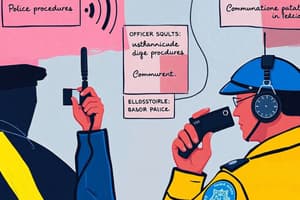Podcast
Questions and Answers
10-17 Unit ______
10-17 Unit ______
Status
10-19 No ______/Messages
10-19 No ______/Messages
Calls
10-63 Settled/______ Report
10-63 Settled/______ Report
No
10-70 Occurred outside ______
10-70 Occurred outside ______
10-71 ______ down
10-71 ______ down
10-68 Extra ______
10-68 Extra ______
10-34 Resume Normal ______ Traffic
10-34 Resume Normal ______ Traffic
Code 10-0 indicates to use ______.
Code 10-0 indicates to use ______.
If an officer needs priority assistance, they would use code 10-______.
If an officer needs priority assistance, they would use code 10-______.
When an officer is out of service, they would report code 10-______.
When an officer is out of service, they would report code 10-______.
Code 10-2 is used to confirm the signal is ______.
Code 10-2 is used to confirm the signal is ______.
Code 10-39 is called for a ______ check.
Code 10-39 is called for a ______ check.
An officer reporting they are en route to headquarters would use code 10-______.
An officer reporting they are en route to headquarters would use code 10-______.
Code 10-51 is a request for a ______ needed.
Code 10-51 is a request for a ______ needed.
The call code for notifying the coroner is 10-______.
The call code for notifying the coroner is 10-______.
The Ten Code 10-3 means to ______ transmitting.
The Ten Code 10-3 means to ______ transmitting.
Emergency Button Activation will display an emergency condition report on all ______ positions.
Emergency Button Activation will display an emergency condition report on all ______ positions.
Calls of a serious nature will be toned utilizing ______ Tone 3 prior to dispatch.
Calls of a serious nature will be toned utilizing ______ Tone 3 prior to dispatch.
In case of an armed robbery, the dispatch will announce: Unit number, S/44 Armed Robbery at ______.
In case of an armed robbery, the dispatch will announce: Unit number, S/44 Armed Robbery at ______.
The term 'radio silence' is used when all radio traffic must ______ except for emergency transmissions.
The term 'radio silence' is used when all radio traffic must ______ except for emergency transmissions.
Officers should not use an OLN when conducting a warrant ______.
Officers should not use an OLN when conducting a warrant ______.
Computer Check Request is coded as section ______.
Computer Check Request is coded as section ______.
Whenever 10-3 is called, all units should hold all transmissions on the radio unless they are of an ______ nature.
Whenever 10-3 is called, all units should hold all transmissions on the radio unless they are of an ______ nature.
Flashcards
10-25 Cancel Other Units
10-25 Cancel Other Units
Units are no longer needed at the scene, all emergency personnel can stand down.
10-26 Request Supervisor
10-26 Request Supervisor
Code used to request immediate supervisor assistance at the scene.
10-27 License Information
10-27 License Information
Requesting information about a vehicle or individual, such as license plate, driver's license or registration.
10-29 Wanted/Stolen Check
10-29 Wanted/Stolen Check
Signup and view all the flashcards
10-53 Domestic Situation
10-53 Domestic Situation
Signup and view all the flashcards
10-33 Emergency
10-33 Emergency
Signup and view all the flashcards
10-18 Expedite
10-18 Expedite
Signup and view all the flashcards
10-24 Situation Under Control / Request Another Unit
10-24 Situation Under Control / Request Another Unit
Signup and view all the flashcards
10-52 Ambulance Needed
10-52 Ambulance Needed
Signup and view all the flashcards
10-41 Beginning Duty Tour
10-41 Beginning Duty Tour
Signup and view all the flashcards
10-10 Priority Assistance
10-10 Priority Assistance
Signup and view all the flashcards
10-74 Negative
10-74 Negative
Signup and view all the flashcards
10-75 In Contact with…
10-75 In Contact with…
Signup and view all the flashcards
10-76 Enroute
10-76 Enroute
Signup and view all the flashcards
10-39 Routine Check
10-39 Routine Check
Signup and view all the flashcards
10-5 Relay
10-5 Relay
Signup and view all the flashcards
What is Alert Tone 3 used for?
What is Alert Tone 3 used for?
Signup and view all the flashcards
How does the dispatcher notify units when Alert Tone 3 is used?
How does the dispatcher notify units when Alert Tone 3 is used?
Signup and view all the flashcards
Describe the process when a 911 call comes in for a serious crime.
Describe the process when a 911 call comes in for a serious crime.
Signup and view all the flashcards
When checking for warrants, what should officers use instead of the operator license number?
When checking for warrants, what should officers use instead of the operator license number?
Signup and view all the flashcards
What to do if driver's name and date of birth do not match any records?
What to do if driver's name and date of birth do not match any records?
Signup and view all the flashcards
What does 10-3 mean and what is the protocol?
What does 10-3 mean and what is the protocol?
Signup and view all the flashcards
What happens when the emergency button is pressed on a portable radio?
What happens when the emergency button is pressed on a portable radio?
Signup and view all the flashcards
Explain the procedure when the emergency button on a portable radio is activated?
Explain the procedure when the emergency button on a portable radio is activated?
Signup and view all the flashcards
Study Notes
Conyers Police Department Standard Operating Procedure #5-1
- Effective Date: 10/15/2024
- Subject: Radio Procedures
- Original Issue Date: 1/2002
- Purpose: Establish procedures for radio transmissions by all personnel using portable or mobile devices.
- Policy Goal: Officer safety, radio discipline, continuity of communications, and professional standards.
- Personnel Identification: Badge/radio numbers assigned upon employment or volunteer service. Personnel must identify themselves using badge number, position, or role (e.g. dispatch, communications).
- Radio Communication Methods: Conyers Police Department 10 codes and signals are the primary method for communication between the Communications Center and officers. "Plain talk" is also permitted when necessary.
- Phonetic Alphabet: Used for spelling words or identifying letters.
- Radio Transmission Guidelines:
- Employees transmit badge number on every transmission, except consecutive ones.
- Employees raise radio before each transmission, except emergency situations.
- Acknowledge receipt of information/updates with badge number.
- Minimize unnecessary transmissions.
- Adjust transmission volume for clear reception.
- Field Officer Radio Transmissions:
- Maintain constant radio contact with other personnel.
- Keep dispatcher/supervisor updated on status, intentions, circumstances, and current situation.
- Communication methods may include Mobile Data Computer (MDC) and/or voice.
- Examples of needed information to transmit:
- Availability for calls for service
- Location of calls
- Information on need for backup units, support services, medical personnel
- Supervisor update on condition/time estimates
- Stolen/missing persons(information)
- Code 3 Response: Emergency response mode outlined in SOP 5-4-4. Officers must notify communications when initiating a CODE 3 response.
- Dispatching Calls for Service:
- Call details, information, and updates recorded as they become available.
- Broadcasts crucial info immediately to responding officers.
- Priority Calls: Dispatched first to minimize stack time. Stack time is the elapsed time between a call being received and dispatched to units.
- Mental Health Consumers: If an incident involves a mental health consumer, this info must immediately be provided to responding officers.
- Out of Service: Documentation of officer's status/unavailability for immediate response.
- Failure to Respond: Attempts to contact units if no response. "Alert Tone 1" sounded if no response.
- Arrival/Departure from Scene: GPS logs arrival.
- Vehicle Stops: Vehicle registration/stolen checks performed on stopped vehicles.
- Officer to Officer Traffic: Limited to traffic references related to calls and gathering of police information, and may not interfere with communications to/from dispatch.
- Toned Calls: Serious calls are announced in this way to alert all personnel. Specific incidents, like armed robbery and robberies, are examples of these tones.
- Computer Check Requests: Dispatch provides needed information to officers. Information includes owner's name and NCIC/GCIC if available. Agency specifics for VIN warrants also noted.
- Radio Silence: Radio traffic halted with a 10-3 code except during emergency situations.
- Portable Radio Emergency Buttons: Emergency conditions displayed on consoles and the radio operator will request the status check. -Officer will notify the operator if they are OK, and will need to reset their radio.
- Communications Procedures with Other Agencies: Radio communications initiated in plain English, when necessary, and must not interrupt other agency transmissions.
- Professional Communication Guidelines:
- Brief and clear communications with pleasant/professional attitude.
- Avoid profane language or negative emotions.
- Radio/MDC Practices and Training: Training may be provided for better familiarity with the radio or MDC usage.
- Phonetic Alphabet: List of approved phonetic alphabet letters and corresponding words for use on the radio. (A-Adam, B-Baker, etc.)
Studying That Suits You
Use AI to generate personalized quizzes and flashcards to suit your learning preferences.
Related Documents
Description
Test your knowledge on the Conyers Police Department's Standard Operating Procedure #5-1 related to radio communications. This quiz covers the essential guidelines for officer identification, communication methods, and radio transmission protocols. Ensure you understand the importance of officer safety and professional standards in radio usage.





